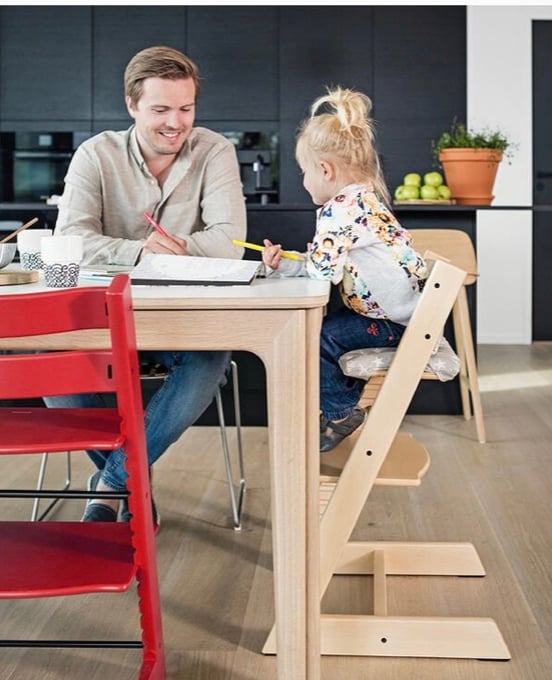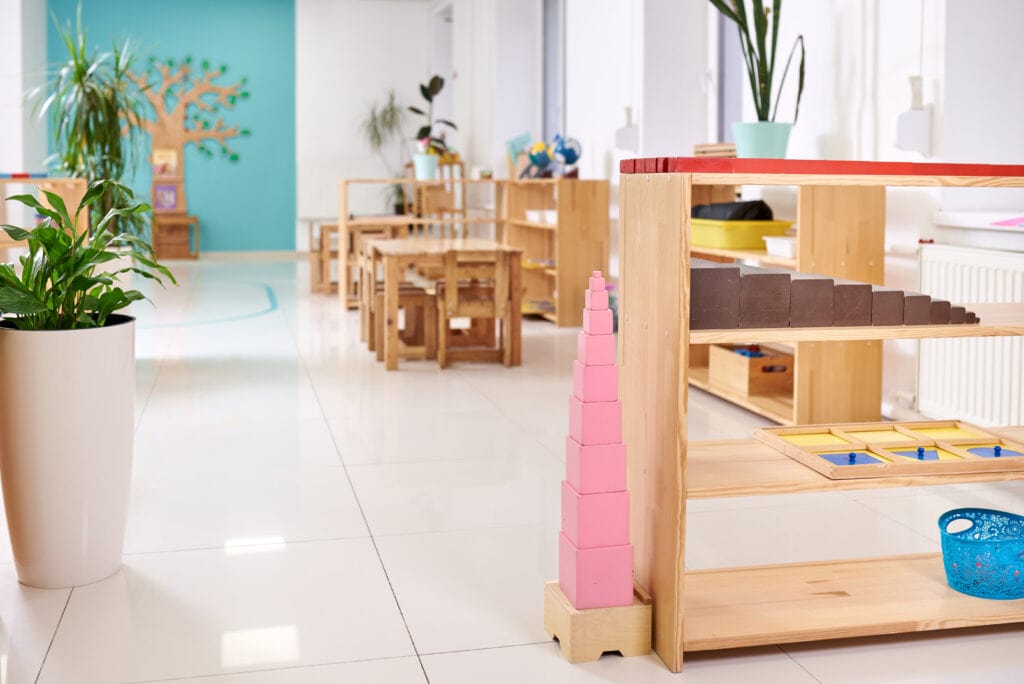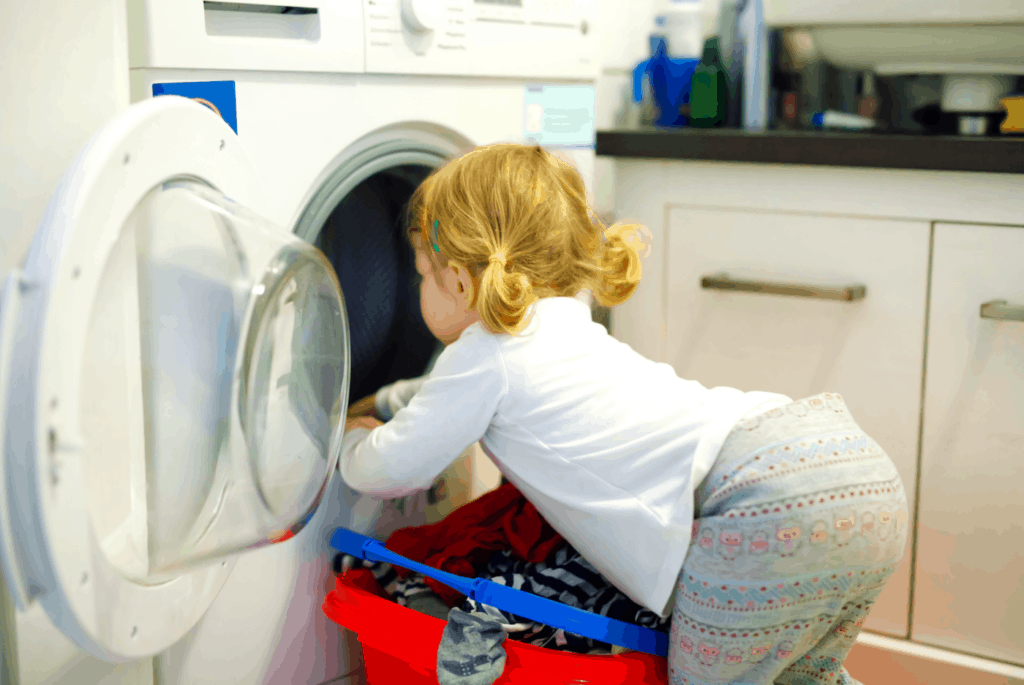Everyone knows how much children love to play in the mud. After all, who hasn’t made a mud pie in their life? In
A mud kitchen is an outdoor play station that allows children to engage in pretend and messy play by cooking with mud, sand, and water. Mud kitchens help children to develop fine motor skills, roleplay, exploration, and social skills. Mud kitchens are beneficial for children ages 1-7.
What exactly is a mud kitchen? What benefits come from children using a mud kitchen? Here is everything that you need to know about Mud kitchens and how they connect to
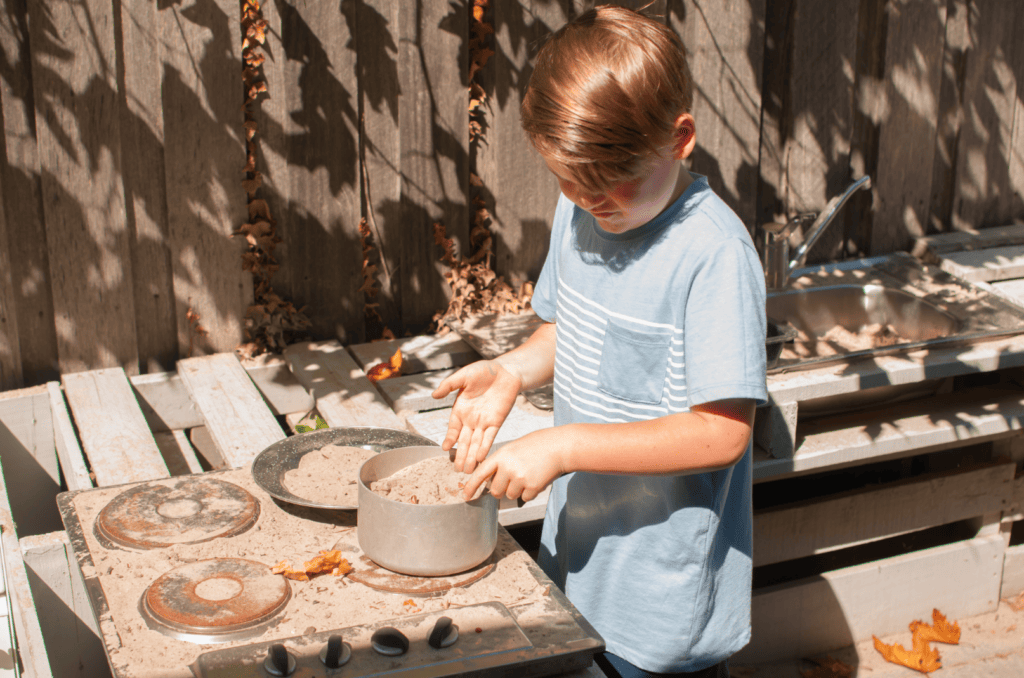
What Is a Mud Kitchen?
A mud kitchen is an outdoor structure used for play. This mud kitchen is a space where children can utilize kitchen tools to pretend to cook with any variation of mud, sand, and water. These mud kitchens usually involve a surface to work, a sink or bin area, as well as shelves, bowls, mud, and other tools.
What should be in a mud kitchen?
“The environment must be rich in motives which lend interest to activity and invite the child to conduct his own experiences.”
MariaMontessori
Mud kitchens vary depending on the individual station and preference. However, mud kitchens usually have the following items:
Pots and Pans: children see their parents cooking with pots and pans all the time and will mimic their cooking methods. Pots and pans provide a container for children to pretend to cook with, and they allow children to exercise what they have seen themselves.
Utensils: Utensils are necessary for any kitchen, and a mud kitchen is no different. Utensils can help children practice fine motor skills by allowing them to mix and create pretend food.
Plastic Jars: Plastic jars provide another container for children to utilize and to store things, such as acorns and homemade potion concoctions.
Tins and other containers: Muffin, pie, and pudding tins are beneficial for children and should be utilized as items in a mud kitchen.
Mixing Bowl: Children use mixing bowls to mix up their food items and practice mimicking what they have seen.
Watering Can: Watering cans help children to add water into their mixtures and to provide a level of control. Pouring practice is also valuable.
Mini Chalk Board: Mini chalkboards are useful for children to practice their writing and drawing skills while in the kitchen. These chalkboards can be a kitchen menu, an ingredient list, or even a drawing area.
Measuring Cups: Measuring cups helps children practice their measuring skills. Measuring and pouring using these cups helps to enhance and hone fine motor skills.
Aprons: Although it is good for children to engage in messy play, aprons should be available in the mud kitchen. If aprons are available and the children choose to wear them, then they can help them learn the value of self-care and staying clean.
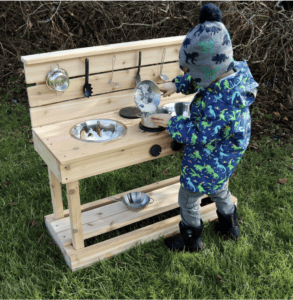
Montessori for Today picks out furniture, educational tools, toys and lifestyle items that we think are the best and most exciting, based on independent research and careful consideration. On some occasions we earn revenue (at no additional cost to you) if you click the links and buy the products. But this doesn’t affect what we choose to highlight and we will never let it bias our coverage.
What Are the Benefits of a Mud Kitchen
Mud kitchens are very beneficial for children. They provide opportunities to grow in almost every aspect. Here are a few of the benefits:
Fine motor skills development: When working in a mud kitchen, children practice using utensils, measuring and pouring mud, and mixing up items. These techniques help children to develop and practice their fine motor skills.
Health benefits: When children get the chance to explore on their own with the freedom to express themselves, their mental health is likely to be higher. They will have greater self-confidence that stems from a sense of competence and self-sufficiency.
Playing in the mud also helps with physical health. Playing in the dirt helps to strengthen and build up the immune system. The more that children are exposed to the bacteria in the dirt, the stronger their immune systems will become. Source
Math skills: A mud kitchen provides lots of opportunities for measuring, weighing, filling, and emptying. All of these contain mathematics and are beneficial in helping children develop and practice basic math.
Roleplay and imaginative play: Mud kitchens allow children creative freedom to play. Imaginative play helps children to develop language skills, practice what they have learned and observed, and helps them make real-world connections.
Sensory development: Sensory play and development are important for children, especially at younger ages. Many preschools have sensory tables that provide different textured items that children can engage with. A mud kitchen is like a sensory table, and it offers lots of nature items with sensory benefits for children.
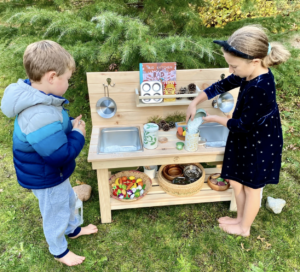
What Age Is a Mud Kitchen For?
Mud kitchens are beneficial for children between the ages of 1 and 7. These mud kitchens help children develop important skills for that age range, and they can creatively explore and express themselves.
Although the suggested age range is between 1 and 7, older children still enjoy messy mud play and will enjoy utilizing a mud kitchen in their back yard.
Are Mud Kitchens Safe?
Although mud kitchens are highly beneficial, many parents worry that mud kitchens can be unsafe for their children. These mud kitchens have a variety of tools and items that can potentially be used for harm. However, in general, mud kitchens are safe for children to use.
If you are worried about your mud kitchen not being safe or appropriate for your child, you can adjust the space to make it age and skill-appropriate. However, do not take away too much because independence and competence are important to the Montessori philosophy.
As far as sanitation goes, playing in mud is perfectly healthy and safe for children. Children should always wash their hands after playing in the mud, and they should choose mud that does not contain any animal waste or stones.
Supervision is recommended while children are playing in their mud kitchens. Parents and teachers should supervise and observe closely, but they should not try and guide or interfere with the play of the child unless there is a safety emergency.

What Mud Do You Use for Mud Kitchens?
Mud that is used specifically for a mud kitchen should be clean of animal feces. The best way to ensure this is to purchase a fresh bag of loam/topsoil. This topsoil should also be free of small stones that can present themselves as choking hazards to young children.
Where to Get Mud for Mud Kitchens:
It is a good idea to purchase topsoil for mud kitchens instead of gathering soil from a garden or the ground. Topsoil can be purchased at any local nursery or plant shop and is also available at your local Walmart.
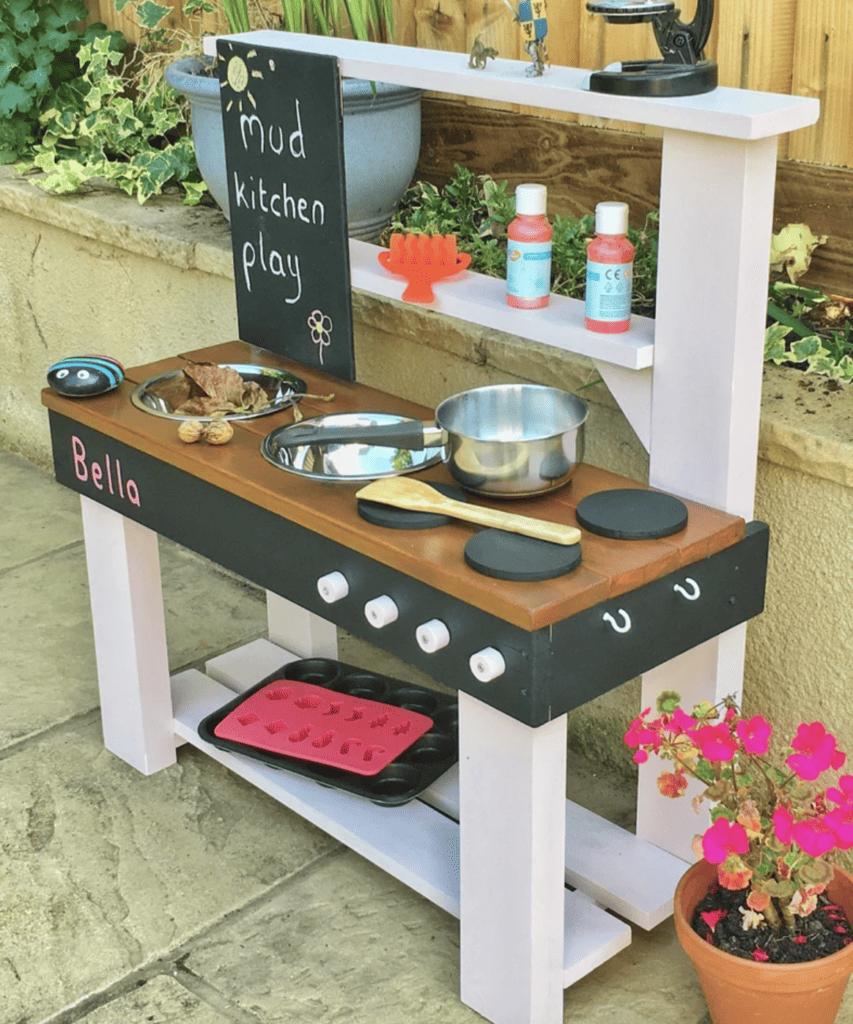
Is a Mud Kitchen Montessori ?
A mud kitchen is a prepared environment, which follows the
Maria
Following these philosophies, a mud kitchen is a
In accordance with the
“Let the children be free; encourage them; let them run outside when it is raining; let them remove their shoes when they find a puddle of water; and, when the grass of the meadows is damp with dew, let them run on it and trample it with their bare feet; let them rest peacefully when a tree invites them to sleep beneath its shade; let them shout and laugh when the sun wakes them in the morning as it wakes every living creature that divides its day between waking and sleeping.”
MariaMontessori

How to Make a Mud kitchen
Mud kitchens are available to purchase at many stores and online from places like Amazon and Etsy. However, many parents chose to make DIY mud kitchens in their own homes.
Making a mud kitchen can be as simple or as complicated as you would like it to be. Most mud kitchens have a surface area for cooking and mixing and a storage area for all the pots, pans, and tools needed. Often these mud kitchens also contain a sink of some sort.
Some people simply put some plywood on top of cinder blocks/rocks and then add a pallet of wood in the background with hooks to hang up the tools. Others construct a complex kitchen with a fancy sink and painted designs. There are many different ways to create a mud kitchen.
However you choose to make your mud kitchen, make sure that it is designed for the child, and not for you. The kitchen should be at the child’s height, and everything should be easily accessible for the child. All the tools and items used need to be consistent with their skill level as well.
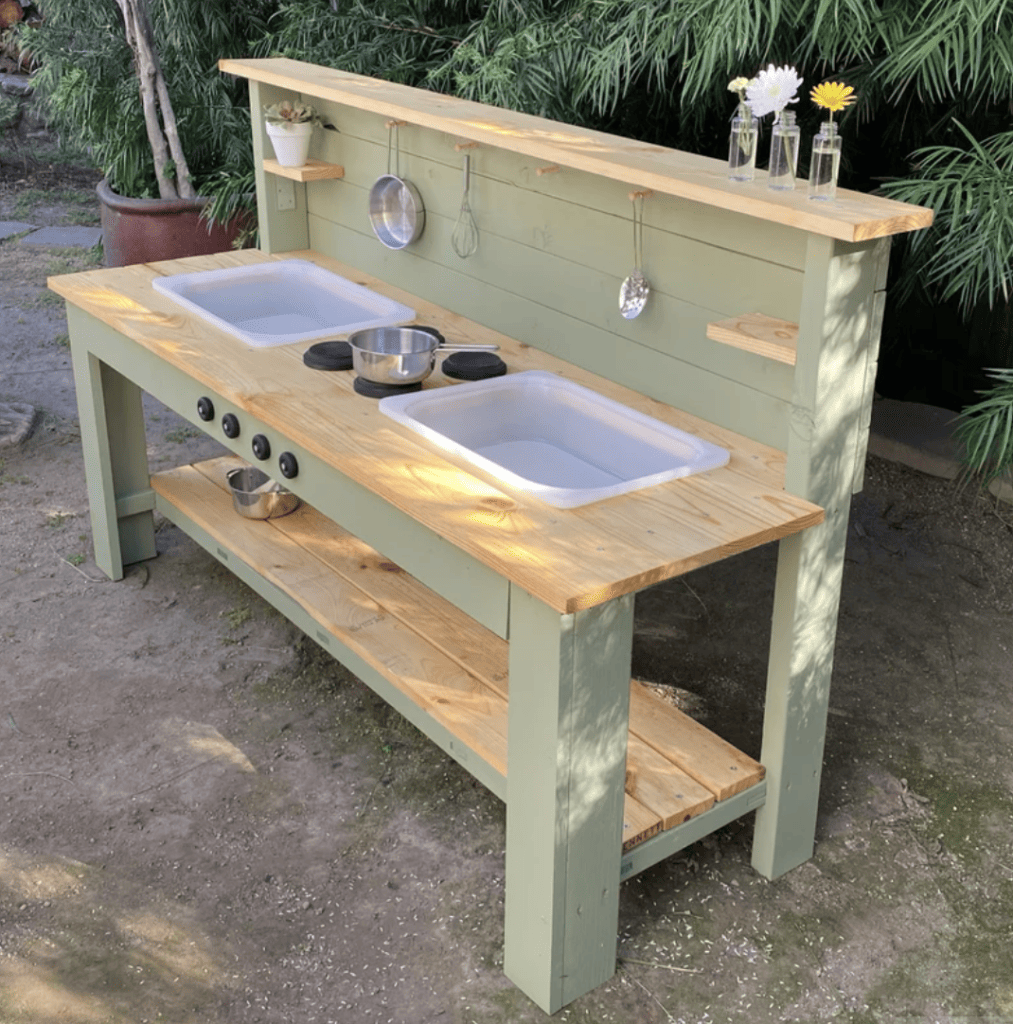
How to Make a Cheap Mud Kitchen
As mentioned above, there are many different variations and types of mud kitchens. If you are looking to create a cheap mud kitchen that does not require an arm and a leg to build, you have come to the right place.
Mud kitchens do not have to be fancy, eloquent, and Pinterest-perfect to be beneficial for your child. You can construct mud kitchens out of very few materials. As mentioned above, you can build a mud kitchen using a wood pallet, a piece of plywood, and some cinder blocks.
You can also make a mud kitchen out of repurposed cabinets, dressers, or other kinds of storage drawers.
DIY plans for mud kitchens can also be purchased on places like Etsy.
Mud kitchens are designed for play and are not meant to be pretty. As long as the mud kitchen is sturdy, safe, and functions, you built it correctly. The video below is a guide on how to make a simple mud kitchen.
How to Weatherproof a Mud Kitchen
Mud kitchens are designed for the outdoor environment. If you plan to create a mud kitchen for your children, the mud kitchen needs to be weatherproof. There are ways to waterproof the wood so that it will not rot. It is a good idea to attach or store a tarp nearby if you want to protect items in the mud kitchen. The tarp should be placed over the mud kitchen during winter or if it is going to rain. This tarp provides an extra layer to keep moisture away.
Waterproofing wood: If you plan to build your mud kitchen with wood, you can waterproof the wood so that it does not go bad. There are a couple of different ways to waterproof your wood.
- Linseed or tung oil: Using linseed or tung oil helps to create a waterproof finish on the wood.
- Varnish: Sealing the wood with varnish, polyurethane, or lacquer can help prevent the wood from rotting in the rain.
- Stain-sealant combo: This method finishes and seals the wood at once, creating a waterproof coating.
Where Do You Put a Mud Kitchen?
Mud kitchens are designed for the outdoors. The whole purpose of mud kitchens is to allow children to get messy and play in the dirt, water, mud, and other natural items.
Choosing a proper placement outside is important for your mud kitchen. The mud kitchen needs to have mud, water, and natural items that are available and accessible. Many parents like to place their mud kitchen against an outside wall of their house, near a water spigot.
The kitchen should also not be closed off from the rest of the outdoor space. It should be readily available and easy to access for the children. These children love to explore, play and gather supplies, and they must have easy access to interact with natural elements.


